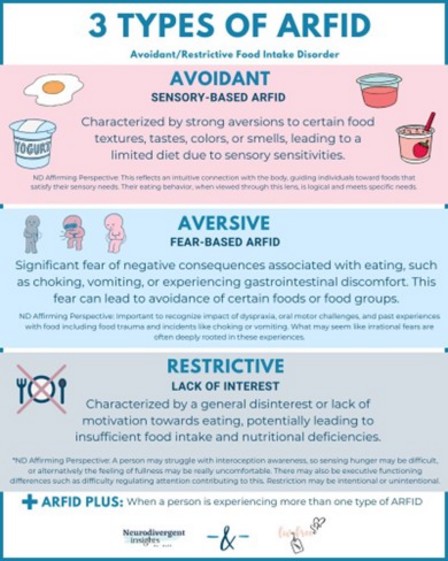(acronym for Avoidant Restrictive Food Intake Disorder)
An eating disorder that causes the individual to limit food intake in volume and/or variety. This avoidance may be based on appearance, smell, taste, texture (due to sensory sensitivity), fear of adverse consequences, lack of interest in food or a past negative experience with a meal. This behavior can lead to nutritional deficiencies, stunted growth or other health problems.
Unlike anorexia nervosa, it is not caused by a concern for body appearance or an attempt to lose weight, and appears to be more common in boys. Onset is earlier than in anorexia nervosa.
Anxiety or autistic spectrum disorders (RR: 9.7), intellectual retardation (RR 10.3), severe gastroesophageal reflux (RR 6.7), pituitary endocrine problems (RR 5.6), epilepsy (RR 5.8) and lower respiratory infections (RR 4.9) are often present.
Depending on the predominance of signs and symptoms, 3 forms can be considered :
- an avoidant form: based on the appearance or texture of foods
- an aversive form: based on the fear of physical consequences after eating a particular type of food: vomiting, abdominal pain, etc.
- a restrictive form: the child has no interest in eating

Most sufferers maintain a healthy body weight, but cases of severe undernutrition have been described.
Treatment: psychotherapy with reward and relaxation phases.
Anesthetic implications:
screening for malnutrition (BMI calculation) and biological work-up if present; significant risk of severe gastro-oesophageal reflux and pituitary problems.
References :
- Feillet F, Bocquet A, Briend A, Chouraqui J-P, Darmaun D, M.-L. Frelut M-L et al.
Risques nutritionnels des troubles d’alimentation sélective et/ou d’évitement (ARFID) / Nutritional risks of ARFID (avoidant restrictive food intake disorders) and related behavior.
Perfectionnement en Pédiatrie 2020 ; 3 :40-4
- Wronski M-L, Kuja-Halkola R, Hedlund E, Martini MI, Lichtenstein P, Lundstrom S, Larsson H, Taylor MJ, Micali N, Bulik CM, Dinkler L.
Mental and somatic conditions in children with the broad Avoidant Restrictive Food Intake Disorder phenotype.
JAMA Pediatr. doi:10.1001/jamapediatrics.2024.6065
Updated: March 2025